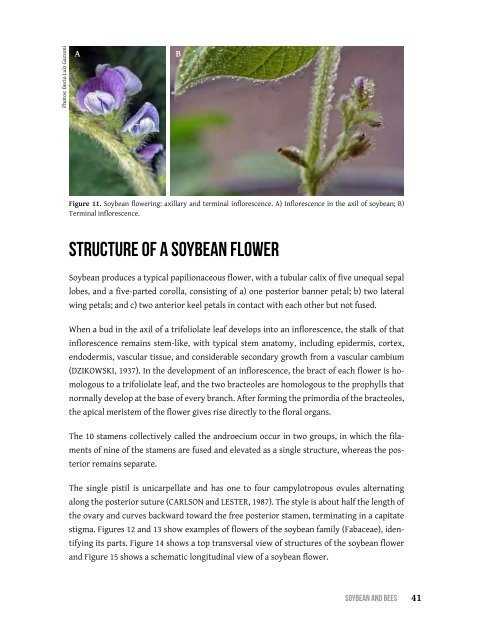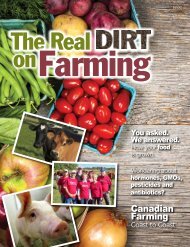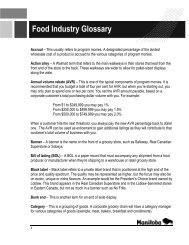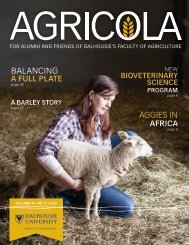SOYBEAN and BEES
BFhV4z
BFhV4z
You also want an ePaper? Increase the reach of your titles
YUMPU automatically turns print PDFs into web optimized ePapers that Google loves.
Photos: Decio Luiz Gazzoni<br />
A<br />
B<br />
Figure 11. Soybean flowering: axillary <strong>and</strong> terminal inflorescence. A) Inflorescence in the axil of soybean; B)<br />
Terminal inflorescence.<br />
Structure of a soybean flower<br />
Soybean produces a typical papilionaceous flower, with a tubular calix of five unequal sepal<br />
lobes, <strong>and</strong> a five-parted corolla, consisting of a) one posterior banner petal; b) two lateral<br />
wing petals; <strong>and</strong> c) two anterior keel petals in contact with each other but not fused.<br />
When a bud in the axil of a trifoliolate leaf develops into an inflorescence, the stalk of that<br />
inflorescence remains stem-like, with typical stem anatomy, including epidermis, cortex,<br />
endodermis, vascular tissue, <strong>and</strong> considerable secondary growth from a vascular cambium<br />
(Dzikowski, 1937). In the development of an inflorescence, the bract of each flower is homologous<br />
to a trifoliolate leaf, <strong>and</strong> the two bracteoles are homologous to the prophylls that<br />
normally develop at the base of every branch. After forming the primordia of the bracteoles,<br />
the apical meristem of the flower gives rise directly to the floral organs.<br />
The 10 stamens collectively called the <strong>and</strong>roecium occur in two groups, in which the filaments<br />
of nine of the stamens are fused <strong>and</strong> elevated as a single structure, whereas the posterior<br />
remains separate.<br />
The single pistil is unicarpellate <strong>and</strong> has one to four campylotropous ovules alternating<br />
along the posterior suture (Carlson <strong>and</strong> Lester, 1987). The style is about half the length of<br />
the ovary <strong>and</strong> curves backward toward the free posterior stamen, terminating in a capitate<br />
stigma. Figures 12 <strong>and</strong> 13 show examples of flowers of the soybean family (Fabaceae), identifying<br />
its parts. Figure 14 shows a top transversal view of structures of the soybean flower<br />
<strong>and</strong> Figure 15 shows a schematic longitudinal view of a soybean flower.<br />
SoybeAn <strong>and</strong> bees<br />
41






